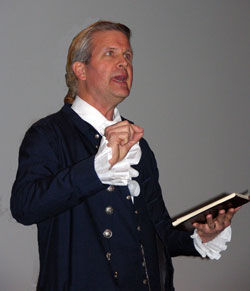 |
Thomas Jefferson impersonator Patrick Lee gives a lecture on 18th and 19th century medicine on Tuesday in the Durham Research Center Auditorium. Lee’s lecture was part of a partnership between UNMC and the Durham Western Heritage Museum. |
During the free noon lecture, the result of UNMC’s partnership with the Durham Western Heritage Museum, Jefferson mentioned the works of physician authors Benjamin Rush, William Buchan and Edward Jenner, whose books can be found in UNMC’s McGoogan Library of Medicine, as well as minister Cotton Mather, whose work the library has on microfilm.
In addition to past medical practices, Jefferson discussed Meriwether Lewis and the Corps of Discovery, slavery, George Washington, his love of books and the many inventions he did not patent.
In conclusion, the author of the Declaration of Independence issued three challenges to the UNMC audience:
UL>
In addition to on-campus lectures, UNMC’s partnership with the Durham Western Heritage Museum allows students and employees from UNMC, UNMC Physicians and The Nebraska Medical Center to visit the museum free year-round with valid identification.
On Saturday, the museum unveils The Signers, a new exhibit examining the lives of the 56 men who signed the Declaration of Independence. The exhibit includes 46 of the original signatures of the signers on varying documents, ranging from letters to land deeds that are a part of the museum’s Byron Reed Collection. The remaining 10 signers are represented by facsimile documents acquired from the Library of Congress.